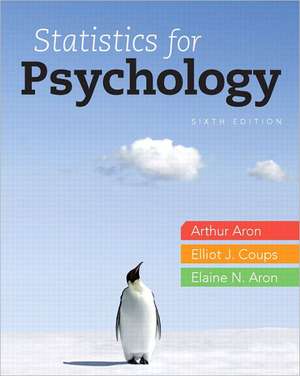Statistics for Psychology
Autor Arthur Aron, Elliot J. Coups, Elaine N. Aronen Limba Engleză Hardback – 30 iun 2012
- Know both definitional and numerical formulas and how to apply them
- Understand the logic behind each formula
- Expose students to the latest thinking in statistical theory and application
- Prepare students to read research articles
- Learn how to use SPSS
Preț: 1632.45 lei
Preț vechi: 2120.07 lei
-23% Nou
Puncte Express: 2449
Preț estimativ în valută:
312.47€ • 339.52$ • 262.64£
312.47€ • 339.52$ • 262.64£
Carte disponibilă
Livrare economică 31 martie-14 aprilie
Preluare comenzi: 021 569.72.76
Specificații
ISBN-13: 9780205258154
ISBN-10: 0205258158
Pagini: 728
Dimensiuni: 201 x 254 x 30 mm
Greutate: 1.38 kg
Ediția:6
Editura: Pearson Education
ISBN-10: 0205258158
Pagini: 728
Dimensiuni: 201 x 254 x 30 mm
Greutate: 1.38 kg
Ediția:6
Editura: Pearson Education
Cuprins
In this Section: 1. Brief Table of Contents 2. Full Table of Contents 1. BRIEF TABLE OF CONTENTS Chapter 1 Displaying the order in a group of numbers Chapter 2 Central tendency and variability Chapter 3 Some key ingredients for inferential statistics: Z scores, the normal curve, sample versus population, and probability Chapter 4 Introduction to hypothesis testing Chapter 5 Hypothesis testing with means of samples Chapter 6 Making sense of statistical significance: Effect size and statistical power Chapter 7 Introduction to the t test: Single sample and dependent means Chapter 8 The t test for independent means Chapter 9 Introduction to the analysis of variance Chapter 10 Factorial analysis of variance Chapter 11 Correlation Chapter 12 Prediction Chapter 13 Chi-square tests Chapter 14 Strategies when population distributions are not normal: Data transformations and rank-order tests Chapter 15 Integration and the general linear model and Making sense of advanced statistical procedures in research articles 2. FULL TABLE OF CONTENTS Chapter 1: Displaying the order in a group of numbers The Two Branches of Statistical Methods Some Basic Concepts Frequency Tables Histograms Shapes of Frequency Distributions Controversy: Misleading Graphs Frequency Tables and Histograms in Research Articles Summary Key Terms Example Worked-Out Problems Practice Problems Using SPSS Chapter Note Chapter 2: Central tendency and variability Central Tendency Variability Controversy: The Tyranny of the Mean Central Tendency and Variability in Research Articles Summary Key Terms Example Worked-Out Problems Practice Problems Using SPSS Chapter Note Chapter 3: Some key ingredients for inferential statistics: Z scores, the normal curve, sample versus population, and probability Z Scores The Normal Curve Sample and Population Probability Controversies: Is the Normal Curve Really So Normal? And Using Nonrandom Samples Z Scores, Normal Curves, Samples and Populations, and Probabilities in Research Articles Advanced Topics: Probability Rules and Conditional Probabilities Summary Key Terms Example Worked-Out Problems Practice Problems Using SPSS Chapter Note Chapter 4: Introduction to hypothesis testing A Hypothesis-Testing Example The Core Logic of Hypothesis Testing The Hypothesis-Testing Process One-Tailed and Two-Tailed Hypothesis Tests Controversy: Should Significance Tests Be Banned? Hypothesis Tests in Research Articles Summary Key Terms Example Worked-Out Problems Practice Problems Using SPSS Chapter Note Chapter 5: Hypothesis testing with means of samples The Distribution of Means Hypothesis Testing with a Distribution of Means: The Z Test Controversy: Marginal Significance Hypothesis Tests About Means of Samples (Z Tests) and Standards Errors in Research Articles Advanced Topic: Estimation, Standard Errors, and Confidence Intervals Advanced Topic Controversy: Confidence Intervals versus Significance Tests Advance Topic: Confidence Intervals in Research Articles Summary Key Terms Example Worked-Out Problems Practice Problems Using SPSS Chapter Note Chapter 6: Making sense of statistical significance: Effect size and statistical power Decision Errors Effect Size Statistical Power What Determines the Power of Study The Role of Power Interpreting the Results of a Study Controversy: Statistical Significance versus Effect Size Decision Errors, Effect Size, and Power in Research Articles Advanced Topics; Figuring Statistical Power Summary Key Terms Example Worked-Out Problems Practice Problems Using SPSS Chapter Note Chapter 7: Introduction to the t test: Single sample and dependent means The t Test for a Single Sample The t Test for Dependent Means Assumptions of the t Test for a Single Sample and thet Test for Dependent Means Controversy: Advantages and Disadvantages of Repeated-Measures Designs Single Samplet Tests and Dependent Means t Tests in Research Articles Summary Key Terms Example Worked-Out Problems Practice Problems Using SPSS Chapter Note Chapter 8: The t test for independent means The Distribution of Differences Between Means Hypothesis Testing with a t Test for Independent Means Assumptions of the t Test for Independent Means Effect Size and Power for thet Test for Independent Means Review and Comparison of the Three Kinds oft Tests The t Test for Independent Means in Research Articles Advanced Topic: Power for the t Test for Independent Means When Sample Sizes Are Not Equal Summary Key Terms Example Worked-Out Problems Practice Problems Using SPSS Chapter Note Chapter 9: Introduction to the analysis of variance Basic Logic of the Analysis of Variance Carrying Out an Analysis of Variance Hypothesis Testing with the Analysis of Variance Assumptions in the Analysis of Variance Planned Contrasts Post Hoc Comparisons Effect Size and Power for the Analysis of Variance Controversy: Omnibus Tests versus Planned Contrasts Analyses of Variance in Research Articles Advanced Topic: The Structural Model in the Analysis of Variance Principles of the Structural Model Summary Key Terms Example Worked-Out Problems Practice Problems Using SPSS Chapter Note Chapter 10: Factorial analysis of variance Basic Logic of Factorial Designs and Interaction Effects Recognizing and Interpreting Interaction Effect Basic Logic of the Two-Way Analysis of Variance Assumptions in the Factorial Analysis of Variance Extensions and Special Cases of the Analysis of Variance Controversy: Dichotomizing Numeric Variables Factorial Analysis of Variance in Research Articles Advanced Topic: Figuring a Two-Way Analysis of Variance Advanced Topic: Power and Effect Size in the Factorial Analysis of Variance Summary Key Terms Example Worked-Out Problems Practice Problems Using SPSS Chapter Note Chapter 11: Correlation Graphing Correlations: The Scatter Diagram Patterns in Correlation The Correlation Coefficient Significance of a Correlation Coefficient Correlation and Causality Issues in Interpreting the Correlation Coefficient Effect Size and Power for the Correlation Coefficient Controversy: What is a Large Correlation? Correlation in Research Articles Summary Key Terms Example Worked-Out Problems Practice Problems Using SPSS Chapter Note Chapter 12: Prediction Predictor (X) and Criterion (Y) Variables The Linear Prediction Rule The Regression Line Finding the Best Linear Prediction Rule The Least Squared Error Principle Issues in Prediction Multiple Regression Limitations of Prediction Controversy: Unstandardized and Standardized Regression Coefficients; Comparing Predictors Prediction in Research Articles Advanced Topic: Error and Proportionate Reduction in Error Summary Key Terms Example Worked-Out Problems Practice Problems Using SPSS Chapter Note Chapter 13: Chi-square tests The Chi-Square Statistic and the Chi-Square Test for Goodness of Fit The Chi-Square Test for Independence Assumptions for Chi-Square Tests Effect Size and Power for Chi-Tests for Independence Controversy: The Minimum Expected Frequency Chi-Square Tests in Research Articles Summary Key Terms Example Worked-Out Problems Practice Problems Using SPSS Chapter Note Chapter 14: Strategies when population distributions are not normal: Data transformations and rank-order tests Assumptions in the Standard Hypothesis-Testing Procedures Data Transformations Rank-Order Tests Comparison of Methods Controversy: Computer-Intensive Methods Data Transformations and Rank-Order Tests in Research Articles Summary Key Terms Example Worked-Out Problems Practice Problems Using SPSS Chapter Note Chapter 15: Integration and the general linear model and Making sense of advanced statistical procedures in research articles The General Linear Partial Correlation Reliability Multilevel Modeling Factor Analysis Casual Modeling Procedures That Compare Groups Analysis of Covariance (ANCOVA) Multivariate Analysis of Variance (MANOVA) and Multivariate Analysis of Covariance (MANCOVA) Overview of Statistical Techniques Controversy: Should Statistics Be Controversial? How to Read Results Using Unfamiliar Statistical Techniques Summary Key Terms Example Worked-Out Problems Practice Problems Using SPSS Chapter Note
Recenzii
"I like the order in which the topics are presented. The order is the same way that I would choose if I were writing a text myself." - Kathleen Denson, Texas A&M Commerce "Aron et al. strives to make statistical concepts accessible to students who may not have a background or interests in math." - Brock Kirwan, Brigham Young University "This text is at a level that I would feel comfortable assigning to my intro stats students." - Osvaldo Morera, University of Texas at El Paso "I like that [the text] introduced students to more complex techniques in an effort to help them to understand the articles that they are reading with more complex statistics in them" -Stacey Williams, East Tennessee State University ".The Level of writing is it's strongest assets. Very clear step by step instructions. The level of writing is very appropriate to my students" -Stephen Armeli, Farleigh Dickinson "High-level, clear, comprehensive. The book is effective at helping students understand the material" - Kristin Lane, Bard College
Textul de pe ultima copertă
The goal of this book is to help you understand statistical methods. Our emphasis is on meaning and concepts rather than on symbols and numbers.











